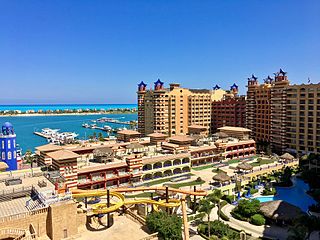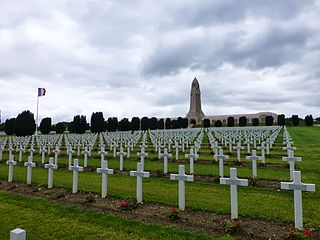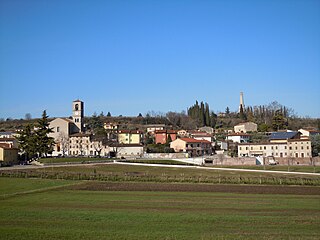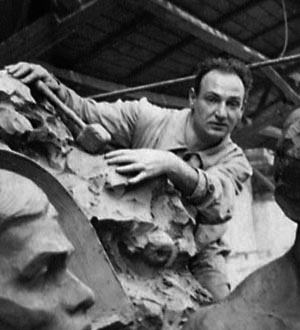
El Alamein is a town in the northern Matrouh Governorate of Egypt. Located on the Arab's Gulf, Mediterranean Sea, it lies 106 kilometres (66 mi) west of Alexandria and 300 kilometres (186 mi) northwest of Cairo. As of 2007, it had a population of 7,397 inhabitants.

The Sedlec Ossuary is a Roman Catholic chapel, located beneath the Cemetery Church of All Saints, part of the former Sedlec Abbey in Sedlec, a suburb of Kutná Hora in the Czech Republic. The ossuary is estimated to contain the skeletons of between 40,000 and 70,000 people, whose bones have, in many cases, been artistically arranged to form decorations and furnishings for the chapel. The ossuary is among the most visited tourist attractions of the Czech Republic, attracting over 200,000 visitors annually.

A war memorial is a building, monument, statue, or other edifice to celebrate a war or victory, or to commemorate those who died or were injured in a war.

Dušan Džamonja was a Yugoslav sculptor of Serbian ancestry.

Sant'Anna di Stazzema, officially Sant'Anna, is a village in Tuscany, Italy. Administratively, it is a frazione of the comune of Stazzema, in the province of Lucca.

Murchison is a small riverside rural village located on the Goulburn River in Victoria, Australia. Murchison is located 167 kilometres from Melbourne and is just to the west of the Goulburn Valley Highway between Shepparton and Nagambie. The surrounding countryside contains orchards, vineyards and dairy farms and also HM Prison Dhurringile. At the 2016 census, Murchison had a population of 925.

Tatura is a town in the Goulburn Valley region of Victoria, Australia, and is situated within the City of Greater Shepparton local government area, 167 kilometres (104 mi) north of the state capital (Melbourne) and 18 kilometres (11 mi) west of the regional centre of Shepparton. At the 2021 census, Tatura had a population of 4,955.

Minidoka National Historic Site is a National Historic Site in the western United States. It commemorates the more than 13,000 Japanese Americans who were imprisoned at the Minidoka War Relocation Center during the Second World War.
In customary international law, an enemy alien is any native, citizen, denizen or subject of any foreign nation or government with which a domestic nation or government is in conflict and who is liable to be apprehended, restrained, secured and removed. Usually, the countries are in a state of declared war.

The Douaumont Ossuary is a memorial containing the skeletal remains of soldiers who died on the battlefield during the Battle of Verdun in World War I. It is located in Douaumont-Vaux, France, within the Verdun battlefield, and immediately next to the Fleury-devant-Douaumont National Necropolis. It was built on the initiative of Charles Ginisty, Bishop of Verdun.

Paolo Caccia Dominioni, born in Nerviano, Lombardy, 14th Baron of Sillavengo ; was an Italian soldier; officer in Alpini mountain Infantry Corps; engineer and writer, most noted for his leadership in the North Africa Campaign in World War II.

Custoza is a northern Italian village and hamlet (frazione) of Sommacampagna, a municipality in the province of Verona, Veneto. As of 2011, its population was 812.

The New Cemetery is a cemetery complex in Belgrade, Serbia, with a distinct history. It is located in Ruzveltova street in Zvezdara municipality. The cemetery was built in 1886 as the third Christian cemetery in Belgrade and as the first architecturally and urbanistically planned cemetery in Serbia.
Honouliuli National Historic Site is near Waipahu on the island of Oahu, in the U.S. state of Hawaii. This is the site of the Honouliuli Internment Camp which was Hawaiʻi's largest and longest-operating internment camp, opened in 1943 and closed in 1946. It was designated a National monument on February 24, 2015, by President Barack Obama. The John D. Dingell, Jr. Conservation, Management, and Recreation Act, signed March 12, 2019, redesignated it as Honouliui National Historic Site. The internment camp held 320 internees and also became the largest prisoner of war camp in Hawaiʻi with nearly 4,000 individuals being held. Of the seventeen sites that were associated with the history of internment in Hawaiʻi during World War II, the camp was the only one built specifically for prolonged detention. As of 2015, the new national monument is without formal services and programs.

World War I is remembered and commemorated by various war memorials, including civic memorials, larger national monuments, war cemeteries, private memorials and a range of utilitarian designs such as halls and parks, dedicated to remembering those involved in the conflict. Huge numbers of memorials were built in the 1920s and 1930s, with around 176,000 erected in France alone. This was a new social phenomenon and marked a major cultural shift in how nations commemorated conflicts. Interest in World War I and its memorials faded after World War II, and did not increase again until the 1980s and 1990s, which saw the renovation of many existing memorials and the opening of new sites. Visitor numbers at many memorials increased significantly, while major national and civic memorials continue to be used for annual ceremonies remembering the war.

Giannino Castiglioni was an Italian sculptor and medallist. He worked mostly in monumental and funerary sculpture; his style was representational, and far from the modernist and avant-garde trends of the early twentieth century.

The Cer Memorial is a war memorial commemorate the Battle of Cer, fought in 1914 as part of the First World War. It is situated on the battlefield, in the village of Tekeriš on the mountain Cer, near Loznica, Serbia. Memorial ossuary Cer is on the list of Immovable Cultural Heritage of Exceptional Importance.
Italian prisoners of war in Australia were Italian soldiers captured by the British and Allied Forces in World War II and taken to Australia.

The Oslavia War Memorial is an Italian monument to soldiers who fell in battle during the battles of the Isonzo, particularly those who died during the taking of Gorizia in 1916. It stands on a 150m hill in the village of Oslavia, on the outskirts of Gorizia. The hilltop was on the front line as Austro-Hungarian troops defended the salient around Gorizia during the first, third and fourth battles of the Isonzo.

















